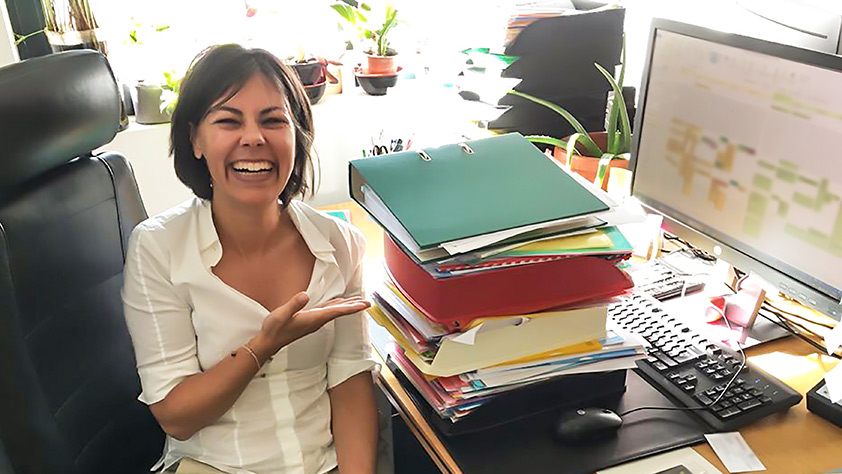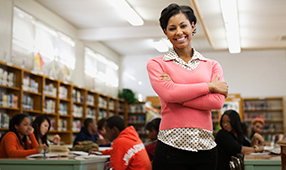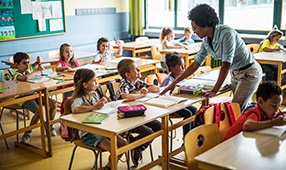Want to feel less stressed at school? According to Nina Miller, organization expert from The Container Store, an organized classroom helps you feel less stressed and promotes better learning.
When you’re organized, it’s easier to find things when you (or your students) need them. When you’re absent, substitutes can fill in seamlessly. Less of your precious time is wasted on re-handling paperwork and de-cluttering, and less money is wasted on rushing out to buy things you’ve run out of or have but can’t find.
Even better, if you and your classroom are well-organized, your class is more likely to run like a well-oiled machine.
“Finding your organizing style is the key to organizing success,” says Diane Gosney, a member of the National Association of Professional Organizers and owner of Organize It with Diane in the San Francisco Bay Area. “Often people try to duplicate a system that a friend or co-worker is using only to give up on it a few weeks later” because it doesn’t fit their organizing style.
When you know what your organizing style is, you can “develop systems that match your way of thinking and are easy to maintain,” Gosney says.
So what’s your organizing style? Here’s a just-for-fun mini-quiz to find out.
Each question presents an organization problem. Choose the a, b, or c answer that’s closest to what you would to do solve the problem.
1. You’re getting lost in piles of paperwork so you...
a.) File the current pile in an expandable pocket folder with divider tabs labeled by alphabet, month and number, then close the cover and put it away. When new paperwork needs attention, file it promptly in the expandable folder.
b.) Put paperwork in an open-top standing Stadium File with expanding pockets arranged in tiers that allow you to see everything at a glance.
c.) Drop all the paperwork in a multi-purpose bin that’s big enough to hold file folders as well as loose papers. This type of system prevents them from getting lost and you’re free to sort later when time allows.
2. Your cleaning supplies are scattered all around your classroom so you...
a.) Arrange the supplies in labeled baskets, put the baskets on shelves near the sink, hidden away in a cupboard or closet. Label the shelves to help make sure baskets are returned to the right place in the future.
b.) Hang a see-through overdoor shoe bag over the supply closet door (or hook it on a hanging rack). Put your cleaning products in the pockets, arranging them so the ones you use most often are easiest to see and to reach.
c.) Pile all the cleaning supplies into a clear plastic storage tote box and tuck the box under the sink or on the floor where it will be easy to pull out and push back as needed.
3. A substitute couldn’t find important forms she needed while you were away. You looked and couldn’t find them either so you...
a.) Organize all your important forms, permission slips and related documents in a three-ring binder, with index dividers to separate forms or categories. Make separate binders for substitute instruction, lesson ideas and plans, and other paperwork you may not use often but need to have handy.
b.) Place forms and permission slips into translucent file folders you can read through, then stand the folders in sturdy clear magazine files where subs can find them when they need them.
c.) Gather all the forms, permission slips and related documents and place them into an empty desk drawer. At least you know they’re all in one place. The sub can sort through the drawer when she needs a document.
4. You have stacks of student handouts, worksheets and other papers ready for distribution to your class but they’re not organized by subject, period or day so you...
a) Designate a crate for all your handouts. In it, set up folders for each subject, period or day of the week. Whenever you make handout copies, file them in the appropriate folder so they’re organized and ready to use when you need them.
b) Clear a space on top of a bookshelf, on a shelf, in a cabinet or in a closet and designate an area for each subject, period and day of the week. Then label that shelf and place your stacks of copies in the designated space with the most current copies on top.
c) Pile them all into a tote for now. You know what’s in there and you can root around and find what you need. It’s also easy to stash wherever you want it—and easy to move if change your mind.
Now count how many times you answered a, b, or c.
If you chose more (a) answers, you’re probably a STOW type. You prefer to stow everything neatly out of sight to keep work surfaces clear. In your classroom, you have designated a place for everything and you keep everything in its place.
A majority of (b) answers means you’re probably a SHOW type. You like a neat classroom, but putting things away can mean “out of sight, out of mind.” You need visual cues to stay organized.
Mostly (c) answers suggest you’re an I DON’T KNOW type. You are either a mix of STOW and SHOW, or you want to be organized but you’re overwhelmed. You don’t know what to do or where to begin. If you do fall into this group, there are countless resources to help you get started! See if you gravitate toward either the STOW or SHOW type. And try sites like FlyLady and UnClutterer to get started.
When trying new organizing techniques, allow yourself plenty of time to adjust to the new methods. “Don’t expect organization to happen overnight,” says Miller. Be flexible. Use storage tools that can be repurposed as your needs change.
So which type is best? They’re all good! They’re just different ways to approach the same problem.
Whatever your organizing style may be, embrace it, says Gosney, and make it work for you.












